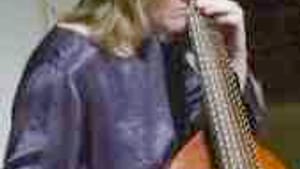Stay in the Loop
BSR publishes on a weekly schedule, with an email newsletter every Wednesday and Thursday morning. There’s no paywall, and subscribing is always free.
Music for the royal couch potato
Tempesta di Mare channels Couperin and Louis XIV

Until the French invented the sofa in 1685, sitters had to be content, at best, with wooden armchairs, unsuited for lounging and other horizontal activities. The new innovation was so popular that cabinetmakers who specialized in sofas quickly became an important part of the Parisian work force.
Tempesta di Mare preceded its latest concert with an entertaining lecture by Penn scholar Joan deJean, the author of The Age of Comfort: When Paris Discovered Casual. Dr. deJean is the kind of scholar who can talk about her subject with the ease of a raconteur who has volumes of anecdotes and facts stored in her head.
When we picture Louis XIV, Dr. deJean noted, we usually think of the Grand Monarch clothed in heavy robes that accentuated the monarchy's grandeur. But Louis actually spent much of his time in smaller chateaus on the grounds of Versailles, wearing dressing gowns and slippers and enjoying private pleasures.
The lecture and the program notes made a critical contribution to a program devoted to the music François Couperin created for the private Sunday concerts that Louis enjoyed. The music that Tempesta's chamber players presented at this event wasn't as lively as some of their other offerings, but you could enjoy it on its own terms if you put yourself in the setting that produced it. Some people spend Sunday reading the New York Times. Louis XIV summoned Francois Couperin and his court chamber players.
Up from the shadows
One of the program's highlights was the opportunity to hear solos by three musicians who normally occupy supporting roles: harpsichordist Adam Pearl, gamba player Sarah Cunningham and theorbo player Richard Stone.
In Baroque music, those three instruments normally provide an accompaniment for the lead players. The gamba— a cousin of the modern cello— plays the bass line while chording instruments such as the harpsichord and the theorbo (a bass lute with a neck about five feet long) fill in the harmonies.
Pearl got the evening off to a good start with a rolling, sensuous piece. Stone soloed with a rondo that Louis's court lutenist, Robert de Visee, arranged from a Couperin harpsichord piece. This work is labeled Les Sylvains ("the forest sprites") and Stone played it with an easy, natural style that fit the title and probably concealed a host of technical challenges.
There was nothing flashy or showy about Sarah Cunningham's solo turn, but you could see why the program notes emphasized its virtuoso nature if you watched her left hand maneuver across the strings of her gamba. Many virtuoso pieces are interesting primarily because they feature dramatic contrasts and high-speed runs. Couperin avoided pointless display and placed technique at the service of art.
Royal attention spans
Couperin may have composed for a one-man audience, but he obviously understood audience psychology. The program contained more movements marked grave and gravement than I would have liked, but Couperin usually hopped to a friskier gaiement or anime about the time I started thinking a change of pace might be nice. Louis XIV lived in an earlier age than we moderns, so presumably he possessed a longer attention span and a larger appetite for slow, deep music.
Most of the pieces on the program teamed the continuo instruments with the voices of the wooden Baroque flute, the mellow Baroque oboe, and two Baroque violins. Gwyn Roberts's flute sounded especially good. The Baroque flute is less penetrating than the modern metal flute and doesn't always carry well, but that wasn't a problem at this event.
Comic strip resemblance
Oboist Debra Nagy added proper helpings of brightness and tenderness to the mix, and at times the flute-oboe sonorities provided the main attraction of a passage. Violinists Emlyn Ngai and Karina Fox were deprived of the kind of showy interludes that composers usually hand violinists but they made their usual contributions to the program's overall grace. In one particularly attractive moment toward the end of the concert, the two winds and the two violins played a sweet passage that sounded like a duet for the two sections.
The comic-strip king in the Wizard of Id has always reminded me of Louis XIV. The Sun King could be a real grade-A tyrant, but he was also a man of human foibles and virtues that inspire a kind of bemused affection. There's much to be said for a guy who likes to lounge around on a sofa and listen to the music of Couperin.
Tempesta di Mare preceded its latest concert with an entertaining lecture by Penn scholar Joan deJean, the author of The Age of Comfort: When Paris Discovered Casual. Dr. deJean is the kind of scholar who can talk about her subject with the ease of a raconteur who has volumes of anecdotes and facts stored in her head.
When we picture Louis XIV, Dr. deJean noted, we usually think of the Grand Monarch clothed in heavy robes that accentuated the monarchy's grandeur. But Louis actually spent much of his time in smaller chateaus on the grounds of Versailles, wearing dressing gowns and slippers and enjoying private pleasures.
The lecture and the program notes made a critical contribution to a program devoted to the music François Couperin created for the private Sunday concerts that Louis enjoyed. The music that Tempesta's chamber players presented at this event wasn't as lively as some of their other offerings, but you could enjoy it on its own terms if you put yourself in the setting that produced it. Some people spend Sunday reading the New York Times. Louis XIV summoned Francois Couperin and his court chamber players.
Up from the shadows
One of the program's highlights was the opportunity to hear solos by three musicians who normally occupy supporting roles: harpsichordist Adam Pearl, gamba player Sarah Cunningham and theorbo player Richard Stone.
In Baroque music, those three instruments normally provide an accompaniment for the lead players. The gamba— a cousin of the modern cello— plays the bass line while chording instruments such as the harpsichord and the theorbo (a bass lute with a neck about five feet long) fill in the harmonies.
Pearl got the evening off to a good start with a rolling, sensuous piece. Stone soloed with a rondo that Louis's court lutenist, Robert de Visee, arranged from a Couperin harpsichord piece. This work is labeled Les Sylvains ("the forest sprites") and Stone played it with an easy, natural style that fit the title and probably concealed a host of technical challenges.
There was nothing flashy or showy about Sarah Cunningham's solo turn, but you could see why the program notes emphasized its virtuoso nature if you watched her left hand maneuver across the strings of her gamba. Many virtuoso pieces are interesting primarily because they feature dramatic contrasts and high-speed runs. Couperin avoided pointless display and placed technique at the service of art.
Royal attention spans
Couperin may have composed for a one-man audience, but he obviously understood audience psychology. The program contained more movements marked grave and gravement than I would have liked, but Couperin usually hopped to a friskier gaiement or anime about the time I started thinking a change of pace might be nice. Louis XIV lived in an earlier age than we moderns, so presumably he possessed a longer attention span and a larger appetite for slow, deep music.
Most of the pieces on the program teamed the continuo instruments with the voices of the wooden Baroque flute, the mellow Baroque oboe, and two Baroque violins. Gwyn Roberts's flute sounded especially good. The Baroque flute is less penetrating than the modern metal flute and doesn't always carry well, but that wasn't a problem at this event.
Comic strip resemblance
Oboist Debra Nagy added proper helpings of brightness and tenderness to the mix, and at times the flute-oboe sonorities provided the main attraction of a passage. Violinists Emlyn Ngai and Karina Fox were deprived of the kind of showy interludes that composers usually hand violinists but they made their usual contributions to the program's overall grace. In one particularly attractive moment toward the end of the concert, the two winds and the two violins played a sweet passage that sounded like a duet for the two sections.
The comic-strip king in the Wizard of Id has always reminded me of Louis XIV. The Sun King could be a real grade-A tyrant, but he was also a man of human foibles and virtues that inspire a kind of bemused affection. There's much to be said for a guy who likes to lounge around on a sofa and listen to the music of Couperin.
What, When, Where
Tempesta di Mare: Couperin, Les Baricades Mysterieuses, La Francoise, Sonade, La Francoise Suite, Les Sylvains, La Sultane; Pièces de Violes; Concert “dans le gout théâtral.†Adam Pearl, harpsichord; Richard Stone, theorbo; Sarah Cunningham, viola da gamba; Gwyn Roberts and Richard Stone, co-directors; Emlyn Ngai, concertmaster. December 11, 2010 at Old St. Joseph’s Church, 320 Willings Alley. (215) 755-8776 or www.tempestadimare.org.
Sign up for our newsletter
All of the week's new articles, all in one place. Sign up for the free weekly BSR newsletters, and don't miss a conversation.

 Tom Purdom
Tom Purdom